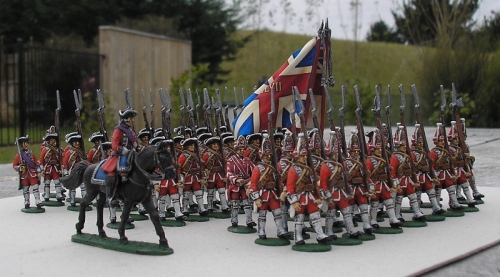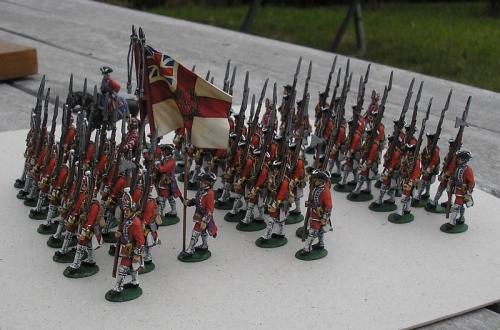As you do when you’ve just finished painting a new unit, I recently put my newly-completed (but not yet based) Minden Miniatures Seven Years War British troops onto their first parade as soon as the last lick of varnish was dry.
A slightly overcast day produced perfect lighting conditions, resulting in a portfolio of photos I’m quite proud of. But a gentle breeze did play havoc with the dressing of the lines, being specially fond of blowing over the standard bearers with a follow-on domino effect through the first company. So the carefully aligned formations in these photos had to be painstakingly redone between each shot!

As you can see, the basing is not yet done. And I have not completely firmed up my ideas on how to do it, either. I’m not going to base for any particular ruleset – at the speed I am painting these large units (three months for this one) I suspect that by the time I have assembled a whole army, the rules that they’ll be used for are probably not even written yet!
The number of figures and the organisation are loosely based on the old wargames rulebook Charge! Or How to Play Wargames. But those rules pre-date the concept of basing entirely, using individual figures that must’ve been an absolute pain to move round the battlefield.
I am inclined towards having eight figure bases made up of two ranks of four. This would make two bases per company. The officers, NCOs, drummers and standard bearers would all be on individual bases so I could position them around the battalion depending on its formation.
However, to throw the cat into the bag, I’ve now also started thinking about having each company based in single, rather than double lines. So a company in line would then be 16 figures long, plus supernumeries. And the whole battalion would be a massive 48 rank-and-file figures long. These days one is more accustomed to seeing miniatures in double lines, but I think that having two ranks represent three or four real ranks is no more realistic than representing the whole company frontage with a dozen or so figures.
Anyway, I haven’t come to a decision yet. So who knows what will happen.

Overall, I have found the Minden Miniatures figures a very paintable range. The sculpting is very crisp, and the detail is easy to pick out. The figures respond particularly well to detailing with GW paint washes. And of course such fine troops deserve the best of flags, and nothing beats GMB Design for these.


More lovely painting (I often use your Napoleonic Spainsh as inspiration). I think that large battalions (I mean 30+ 28mm sized figures) look better in single lines – the size of the figure provides the ‘mass’ if you know what I mean, I think it is much more important to double-rank smaller figures. As for the realism factor, single ranks give both a more accurate footprint and reflect the problems better – try wheeling a three-battalion brigade with a frontage of 130 figures or so!
Regards
Fantastic to see them finished Roly. They will look great in a “Charge” rules game with companies deployed in successive lines. Looking forward to seeing them “live”.
Rhys
Fantastic looking unit! It will surely strike terror in the hearts of its French opponents.
Jim
Beautiful work, Roly!
Best Regards,
Stokes Schwartz
Roly,
I knew of your work by way of the Kapiti Fusiliers site. I just learned of this blog through the Old School Wargaming forum. Anyway, very inspiring work. You’ve created some superb artwork here. I hope one day I’ll have a couple of units -well, at least one judging by the time it takes me to paint- come out half as good as your Minden minis. Thanks for this wonderful post.
Pjotr
http://nyudrevchronicles.blogspot.com/
Personally I feel that single-ranked infantry figures don’t look right. For me they look like skirmish troops bunched together . . . but your lovely figures are not my army, so base them as you please.
I too just learned of your blog. I’ve added it to the “other blogs of interest” on the Emperor vs Elector group blog for 18th Century Imagi-Nations:
http://emperor-elector.blogspot.com/
— Jeff
Roly,
Superb! How wonderful to see BRITISH SYW figures! Mindens are great figures. I look forward to seeing more of these boys.
Theo
… and how do you do the drape of those flags????
Theo
Simple. Glue together with white glue. While still wet, crumple them up.
Here’s the secret: crumple them up *diagonally* from the top, not vertically as most people do.
The diagonal folds give the flag an appearance of having some weight.
You can crumple the flag quite violently, then tease it out a bit till you get the effect you want.
Finally, don’t forget to paint the edges. I used red, blue and linen coloured paints for these particular flags.
Beautiful work, Roly! Sorry to be late for the ball, but regarding your musings on single or double line, I understand your reasoning even though I find double lines look more “right”, esp. with large units like yours. I suppose it depends on your ground scale: How would the actual frontage occupied by a battalion (or regiment) scale down to your tabletop, and would it be vastly exceeded by the single line?
A n excellent British batallion. It is almost the same size as the French napoleonic batallions that I am building up, (in 40mm). Except there would be six companies, 8 figs each, although having seen your troops lined up, 16 figs per company is possible, voltigeur company would be seperate, skirmishing.
Look forward to seeing more, in particular when based. I am thinking 4 figs to a base, command on seperate bases.
well done.